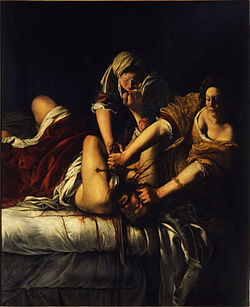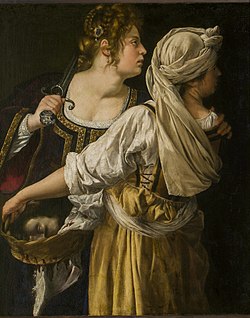Date c. 1623/1625
Medium oil on canvas
Dimensions:
Unframed: 72 7/16 × 55 3/4 inches (184 × 141.6 cm)
Framed: 85 × 68 1/2 × 3 1/2 inches (215.9 × 174 × 8.9 cm)
Detroit Institute of Arts; European Painting: Medieval and Renaissance W220, Level 2
In 1625, Artemisia Gentileschi painted this striking piece titled “Judith and Her Maidservant with the Head of Holofernes.” This is not the first time Artemisia painted Judith and her Maidservant, nor is it her most famous piece. It is simply my most favorite piece because the emotion that is expressed tells an entire story. One does not even have to know the biblical tale of Judith to understand what is going on in this painting. The immediacy and perilousness of their situation is clear, and yet Judith is standing, fully facing into the night and to what might be lurking. What tremendous invulnerability and courage is shown on Judith’s face. I can feel the stillness in the air in that moment. The heat radiating on her body from the candle. The heavy texture of the draped fabrics.
The single flickering candle, brightly glowing in this setting is a stark contrast of the deep shadows and darkness. Who knows what is hiding beyond their sight? Judith and her Maidservant have cut off Holofernes head and are about to make their escape, when Judith hears something. She holds up her hand to cover the bright light in front of her eyes so she might see into the blackness.
In this painting I see luxuriously flowing lines of richly draping fabrics in colors of crimson-red, yellow-gold, and violet-blue contrasting against the dark background. Illuminated by a single light source; the candle brings an emphasis to the expressions, emotions, and urgency of the situation. The primary color triad is well-balanced and pleasing to the eye, with a gold gown in the center symbolic of triumph. There is good harmony and repetition of similar elements throughout the composition.
While it was known that Artemisia personally knew Caravaggio, by no means did she imitate him. She learned techniques and made them her own. As in this painting, one may recognize the techniques of Carravaggio, primarily the use of tenebrism, while the added use of primary colors are without a doubt, instilling a new form belonging only to Artemisia Gentileschi (Caravaggism Painting Techniques).
While this story is graphic, the violence is mostly hidden by the skillful focus upon Judith’s fearlessness. I would gladly own it and have it in my home. Possibly a hallway where I walk by it quite often would be a perfect place to view it; a place where it could be a private and personal reminder. I am so grateful for having learned of Artemisia Gentileschi and her talent; her personal courage and invulnerability; her determination in her life. There is a part of me, and my life experience, that can relate on a deeply personal level.
This was painted while Gentileschi had the patronage of Duke Cosimo II (“Artemisia Gentileschi”).
Comparison with a work from the Renaissance Period:

‘Judith with the head of Holofernes’
Titian, circa 1515
Painting – oil on canvas
Height: 89 cm (35.04 in.), Width: 73 cm (28.74 in.)
Galleria Doria-Pamphilj – Rome
This masterpiece of Titian’s is thought of as one of his finest paintings. What is interesting to note is that there is some debate as to whether this is Salome with the head of John the Baptist, or Judith with the head of Holofernes (Kren and Marx).
One theory that prevails is that there is nothing regal about the two women, and the main figure has a somewhat seductive attitude, so is well suited to the story of Judith. She now holds the head of Holofernes with her Maidservant at her side. This is a theme often used as a symbol of virtue.
The interpretation of Judith may be the correct one, and is confirmed by the 1533 record of a painting by Titian, titled Judith, in the collection of Alfonso I d’Este. It was originally considered lost, but in fact this painting comes from the collection of Lucrezia d’ Este, granddaughter of Alfonso I (Kren and Marx) .
Personally I much prefer Artemisia’s Judith, as she is depicted with strength and courage, having cut off the head of Holofernes, she is facing another possible threat head-on. In Artemisia’s painting it also appears to me as though Judith is acting as guard and protector to her Maidservant. She is showing absolute fearlessness in the face of life-threatening danger. Now that’s my kind of woman.
About the Painter

“Self-Portrait as the Allegory of Painting”
In this self-portrait, “..using her own likeness instead of an idealized figure, Gentileschi tests the conventions of feminine humility..” (Womeninthearts).
Artemisia Gentileschi
1630s
Oil on canvas, 96.5 x 73.7 cm
Royal Collection, Windsor
Artemisia Gentileschi was born on July 8, 1593 in Rome. She was the daughter of the painter Orazio Gentileschi, and was trained by him. Artemisia showed tremendous talent at a young age. At seventeen years, Artemisia Gentileschi experienced the trauma of rape by one of her father’s associates. She suffered through a long and painful trial involving invasive gynecological examinations and thumbscrews (“Artemisia Gentileschi”). This experience deeply affected Artemisia and forever influenced her art. Practically all of her paintings portray a strong woman. During a time when female painters did not ordinarily receive a great deal of recognition, Artemisia gained admittance as the first woman accepted into the Accademia delle Arti del Disegno, or the Academy of the Arts of Drawing, in Florence, Italy (“Artemisia Gentileschi”). Gentileschi’s artistic skills gained patrons of royalty including Cosimo de’ Medici, the grand duke of Tuscany, and in 1627, she received a commission from King Philip IV of Spain (“Artemisia Gentileschi”). She included in her circle many artists, writers, and thinkers, as well as the renowned astronomer Galileo, and the Grand Duchess, Christina of Lorraine (“Artemisia Gentileschi”).
Artemisia’s best-known work:
“Judith Slaying Holofernes” (1614-20)
Medium: Oil on canvas
Dimensions: 158.8 cm × 125.5 cm ((6′ 6″ X 5′ 4″) 78.33 in × 64.13 in)
Location: National Museum of Capodimonte, Naples

Artemisia’s first work of Judith:
“Judith and her Maidservant” (1613-14)
Oil on canvas.
1.14m by 0.935m
Palazzo Pitti, Florence

Work Cited
“Judith Slaying Holofernes (Artemisia Gentileschi).” Wikipedia, Wikimedia Foundation, 27 Sept. 2017, en.wikipedia.org/wiki/Judith_Slaying_Holofernes_%28Artemisia_Gentileschi%29.
Kren, Emil, and Daniel Marx. “TIZIANO Vecellio.” Judith by TIZIANO Vecellio, https://www.wga.hu/html_m/t/tiziano/10/1/04udith.html.
“Tag: Artemisia Gentileschi.” Broad Strokes The National Museum of Women in the Arts Blog, Womeninthearts, 16 Dec. 2016, nmwa.org/blog/tag/artemisia-gentileschi/.


Hi Risa,
Thank you for sharing this painting. I agree with you about it being a wonderful example of tenebrism. I love how Judith’s hand casts a shadow across her face, and how the candlelight illuminates her hand. I thought it was a great work to use when comparing and contrasting the Baroque and the Renaissance. This work evoked a strong emotional interest for me, whereas the Renaissance work made me recoil.
I think I’m most drawn to how carefully rendered Judith and her maid’s expressions are in Gentileschi’s work. The affect of the subjects in the Renaissance portraits feel flat in comparison. Seeing the works like this helped me understand the Council of Trent’s position on art evoking emotion.
Thanks again,
Annie
LikeLiked by 1 person
I love Artemisia’s work too. She was so talented and it’s a tragedy that she only recently got the recognition she deserved by the modern art community. I love how she portrayed the women in her paintings. In this painting, I love the light the candle gives and how it creates the shadows in the piece. My favorite is actually the Judith and her Maidservant where the maidservant has the head in the basket and Judith has the sword over her shoulder and they are looking back.
I examined her Judith Slaying Holofernes painting on my blog. She actually painted the Judith Slaying Holofernes scene twice. Once around 1611-1612 and the second time around 1620-1621. The one you have in her best known works is the 1620 version and is actually in the Uffizi Gallery Museum in Florence. Khan Academy did a great analysis of the painting.
https://www.khanacademy.org/humanities/monarchy-enlightenment/baroque-art1/baroque-italy/a/gentileschi-judith-slaying-holofernes
LikeLiked by 1 person